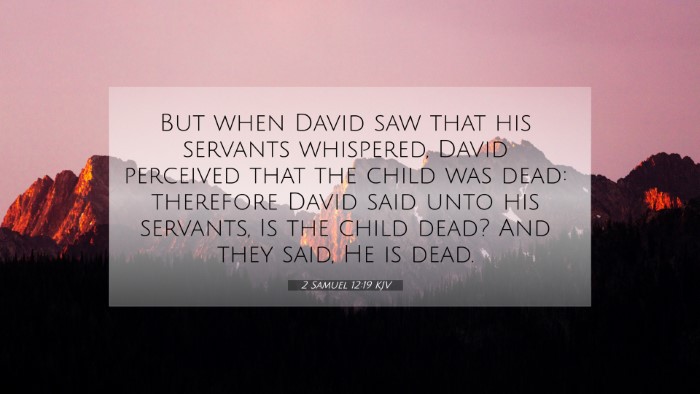Understanding 2 Samuel 12:19
Verse Reference: 2 Samuel 12:19 states, "But when David saw that his servants were whispering, David perceived that the child was dead: therefore David said unto his servants, Is the child dead? And they said, He is dead."
Contextual Background
This verse occurs in the aftermath of Nathan’s prophecy regarding the death of David and Bathsheba's child as a consequence of David's sins. It highlights the moment of realization and acceptance of David regarding his child’s death. This incident is pivotal as it showcases human emotions associated with loss, repentance, and acceptance of God’s will.
Commentary Insights
This verse offers profound insights according to several public domain commentaries:
-
Matthew Henry:
Henry emphasizes the weight of David's emotional struggle. He notes that David, being a father, would feel the pain of losing a child deeply. The observant nature of David shows his sensitivity and intuition as a leader, indicating the sorrow and seriousness of the events that transpired.
-
Albert Barnes:
Barnes discusses the societal implications of the child’s death on David's reign and family. He points out that David's inquiry about the child reflects a king's need for clarity amidst chaos, and how this moment signifies a profound turning point in David’s life and leadership.
-
Adam Clarke:
Clarke elaborates on the desperation and grief involved. He reflects on the psychological aspect of David’s question and how such moments challenge faith. Also, he notes how this event correlates with God’s mercy and judgment, illustrating the duality of divine justice.
Thematic Bible Verse Connections
This verse can be cross-referenced with several other biblical texts that illuminate its meanings, such as:
- 2 Samuel 12:14: This verse talks about the consequences of sin and the severe ramifications that followed David's actions.
- Psalm 51:1-2: David’s heartfelt cry for mercy post-sin gives context to his emotional turmoil during the loss of his child.
- Job 1:21: Job's response to his own tragedies emphasizes acceptance of God’s will, akin to David’s progression after his child’s death.
- Romans 8:28: This New Testament reference speaks to the overarching theme of God’s purpose in our sufferings and the eventual good that can arise from heartache.
- 2 Samuel 15:30: This verse illustrates David's personal struggles and further expands on his character's complexities as he faces loss and betrayal.
- Hebrews 12:1-2: This portrays endurance through trials, paralleling David’s eventual resilience and faith post-tragedy.
- Matthew 5:4: This beatitude acknowledges mourning and offers divine consolation, connecting with David's sorrowful moment.
Exploring Connections Between Bible Verses
The connections between these verses not only help frame 2 Samuel 12:19 in a broader theological context but also encourage deeper inquiry:
- Investing Knowledge: Tools for bible cross-referencing can aid in uncovering deeper relationships among the verses, helping individuals to see the narrative arc present in both Old and New Testaments.
- Comparative Bible Study: Engaging in cross-reference methods enhances understanding by shedding light on similar themes like grief, repentance, and divine justice.
- How to use Bible Cross-References: Employing a bible cross-reference guide allows for easier identification of similar narratives or teachings across scripture.
Conclusion
In reflecting on 2 Samuel 12:19, modern readers can find comfort and context in the acknowledgment of suffering, the depths of human emotion, and the pathways to understanding God’s will through pain. The themes of mourning, acceptance, and divine justice resonate throughout the biblical narrative, creating a rich tapestry from which believers can draw strength and understanding. By examining the surrounding passages and employing various bible reference resources, one can uncover a deeper connection to faith amidst trials.
Further Study
For those interested in deeper biblical studies, consider exploring:
- How to find cross-references in the Bible effectively.
- Identifying connections between the Old and New Testament through events such as David’s experience.
- Thematic bible verses that relate to each other in the context of hardship and divine response.
- Tools for comparative studies on Pauline epistles and their connection to Old Testament narratives.


